|
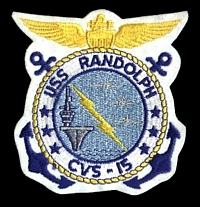 Nuclear
Brief December 20, 2006 Nuclear
Brief December 20, 2006
USS
Randolph and the Nuclear Diplomatic Incident
On July 14, 1966, anti-submarine aircraft carrier USS
Randolph (CVS-15) arrived in Copenhagen for a five-day visit. The ship
was a nuclear-capable vessel with a nuclear strike mission against
submarines. Accompanying the USS Randolph in Copenhagen were the
destroyer USS Borie (DD-704) and the frigate USS Edward Mcdonnell
(FF-1043). The latter was also nuclear-capable, equipped with the ASROC
anti-submarine weapon.
The ship's nuclear capability meant that the visit
became a public and political liability from the start. But while the
public debate quickly died down, declassified Start Department documents
(download copies from the right-hand bar) reveal that the visit set the stage for a nuclear
incident between the two allies that U.S. and Danish diplomats tried for
two years to resolve. The documents show that the U.S. government did
not consider nuclear weapons onboard its warships "deployment" in
Denmark and therefore not affected by Danish non-nuclear policy. In
fact, the State Department believed that Denmark tacitly accepted this
distinction.
At the core of the matter was whether Denmark's
non-nuclear policy should be allowed to influence U.S. naval visits. The
U.S. government insisted it should not, and in the end the Danish
government quietly agreed to ignore its own nuclear policy. But because
the Danish government publicly insisted that its nuclear ban was
respected during port visits, the nuclear collusion set the stage for
decades of political conflicts.
The Visit
At the press conference following the arrival of USS
Randolph in Copenhagen on July 14, Rear Admiral Paul E. Hartman was
asked whether the ship carried nuclear weapons. Hartman said he could neither confirm
nor deny the presence of nuclear weapons on the ship, but added
incorrectly that "all navy ships have capability to carry these
weapons."
The answer satisfied most of the Danish news media,
but the
U.S. Embassy received information after the press conference from
someone with inside knowledge about the newspaper Information and
the Danish government that Information the following day would
report "suspicion of nuclear weapons aboard" USS Randolph. The source
warned that the story could have some political effect "if no action was
taken to deny or blunt it." The source appears to have been
Chief Editor Seidenfarden on Information, the
same paper that printed the nuclear accusations.
To "deflate story," the press attaché at the
U.S. Embassy told the news media that "there were no weapons aboard Randolph
which would violate well-known Danish policy concerning stationing of
nuclear weapons." The reference to "stationing" rather than
"carrying" nuclear weapons was deliberate and intended to refer to
deployment on land versus on a ship.
The Nuclear "Fingerprint"
Despite the attempt to "deflate" the nuclear angle,
U.S. Navy documents declassified under the Freedom of Information Act or
publicly available at military and civilian libraries contain strong
indications that USS Randolph carried nuclear weapons during its North
Atlantic deployment in 1966.
The USS Randolph was a nuclear-capable anti-submarine
aircraft carrier designed to hunt down and destroy Soviet submarines in
times of war. The ship deployed with an escort of frigates, destroyers,
submarines, and supply ships in a Hunter Killer (HUK) task force. During
the North Atlantic deployment in 1966, the Commander Antisubmarine
Warfare Group 4 was embarked on the USS Randolph.
|
USS Randolph
(CVS-15) Underway 1962 |
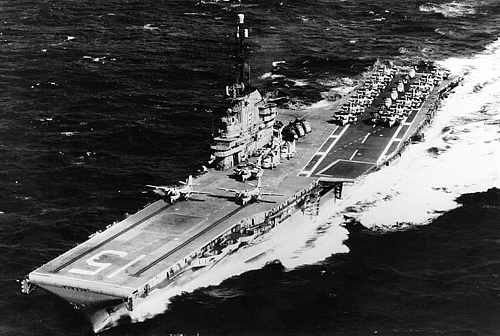 |
|
The USS Randolph (CVS-15)
underway in February 1962, four years before it visited
Copenhagen. The embarked anti-submarine
wing was assigned missions with nuclear depth charges. |
As a nuclear-capable anti-submarine carrier, the crew
of the USS Randolph included a W Division that was responsible for
storing and handling nuclear depth charges for the ship's anti-submarine
wing. The ship's Crew Books identify that the ship during deployments to
the Mediterranean Sea in 1964, 1965 and 1967 included a W Division. The unit
was made up of 24 men in 1965 and 30 in 1967.
The crew book for 1965 is missing from the U.S. Navy's
archives, but the considerable time and resources involved in bringing a
carrier up to the high standard of nuclear weapons proficiency means
that a W Division presumably also was onboard during the North Atlantic
deployment in 1966.
|
USS Randolph
(CVS-15) W Division |
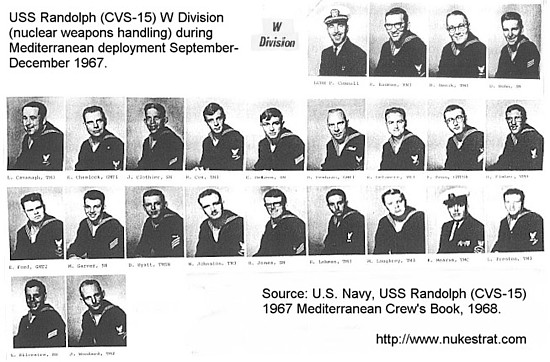 |
|
The USS Randolph (CVS-15) included a W
Division for nuclear weapons handling in 1964, 1965 and 1967, and,
presumably, also in 1966. |
During deployment, the W Division held frequent
loading drills, moving dummy weapons from the Special Weapons spaces
below deck to aircraft on the flight deck. A heavily-armed Marine
Detachment was assigned to protect the weapons against theft and
sabotage.
|
Lulu and
Mk-57
Nuclear Depth Bombs |
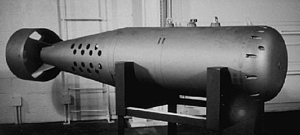 |
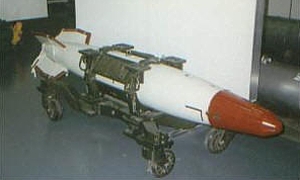 |
|
The Mk-101 Lulu (top) and Mk-57 nuclear depth
bombs were both operational at the time of USS Randolph's
visit to Copenhagen in 1966. |
The nuclear weapons that the W Division
maintained were nuclear depth charges. Two types were operational in the
U.S. Navy in 1966; the Mk-101 Lulu and the Mk-57. Either, or both, may
have been onboard the anti-submarine carrier in 1966.
The Mk-101 Lulu nuclear depth bomb
carried a W34 warhead with a yield of approximately 11 kilotons. The
Mk-101 was operational until the late-1960s when it was replaced with
the Mk-57.
The Mk-57 nuclear strike/depth bomb
contained a 10-kiloton warhead. As the name indicates, the weapon could
be used against both sub-surface and surface targets. The Mk-57 was
later renamed the B57.
The objective of the North Atlantic
deployment was to demonstrate the ability to move a submarine hunter
killer group into any waters with a heavy concentration of hostile ASW
forces. Immediately after the visit to Copenhagen, USS Randolph sailed
north to the Norwegian Sea to take part in exercise Straight Laced.
The NATO exercise was designed to sharpen
the Striking Fleet's coordination with NATO's northern European Command,
and USS Randolph's role was to provide anti-submarine warfare support and surface surveillance
coordination for U.S. and British attack aircraft carriers
operating in the area.
Straight Laced was designed to test the readiness of the
fleet in a series of realistic air, surface and sub-surface maneuvers.
This included air strikes and air defense, cross-servicing (underway
replenishment and refueling, and cross-deck landing operations between
British and American carrier-based aircraft. The exercise includes "strikes from the Norwegian Sea in a nuclear freeplay
environment."
After a brief return to the U.S. East
Coast for repairs in October, USS Randolph was back in the North-West
Atlantic the next month for exercise LANTFLEX
66 in the waters off New England
as flagship for Carrier Task Group (CTG) 20.5. During this exercise nuclear weapons
strike operations were not conducted - apparently contrary to standard
practice - due to inadequate
exercise planning.
The Post
Exercise Report complained that neither the
tempo of operations nor the intelligence released had been sufficiency to meet the
exercise criteria established. The report recommended that "Training in the
current tactics is required of all units if we are to have a valid
capability in the delivery of this potent weapon," and it was
recommended that major exercises such as LANTFLEX 66 "should incorporate the use of such weapons."
The nuclear "fingerprints" and other details about USS
Randolph's operations around the time of its visit to Copenhagen in July
1966 are included in the following table:
|
USS
Randolph (CVS-15)
Nuclear Operations During 1964-1967 |
|
Date |
Description & Remarks |
|
1964 |
During 1964, the ship's
Weapons Department included the Special Weapons "W" Division, which "maintains a
variety of advanced undersea weapons for use against enemy submarines."
According to
USS Randolph: Twenty Years of Service
(Boston, MA: Burdette & Company, Inc., 1965),
"America's anti-submarine forces
were first announced to have nuclear ability in 1957. When nuclear weapons are
aboard, they fall under the cognizance of W Division. Frequent loading drills
are held, moving dummy weapons from the W Division spaces below decks and the
aircraft on the flight deck." |
|
01/29/65 |
Left Norfolk
Naval Shipyard and loaded up ammunition. |
|
02/02-08/65 |
Whiskey Anchorage, Hampton Roads, VA.
Deck Log:
(02/03) 12:30 Commenced loading ammunition. (02/04) 11:50
Barge 367 came along side to port. 12:17 Barge 367 departed
the ship. 12:20 Ammunition barge 362 came alongside. 12:40
Barge 352 Departed the ship. 13:03 Ammunition barge 1195
came alongside. 13:53 Barge 1195 departed the ship. (02/05)
10:35 Received magazine temperature report reports,
conditions are normal. (02/06) 8:10 Received daily magazine
report, conditions normal. 15:43 Class C fire in compartment
B-201-3L. 15:47 Secured from fire quarters. (02/07) 10:00
Made daily inspection of magazines and smokeless powder
samples. Conditions satisfactory. |
|
06/11/65 |
Departs
Norfolk, VA, for Mediterranean deployment. During this
deployment, the ship's Weapons Department included the
Special Weapons "W" Division with 30 crew. |
|
09/02/65 |
Returned to
Norfolk, VA. |
|
09/30/65 |
At Whiskey Anchorage,
Hampton Roads, VA.
Deck Log: 9:05 Commenced transfer of
ammunition. 10:10 Secured transfer of ammunition. |
|
05/16/66 |
Sailed on
Northern European Cruise with a purpose to demonstrate the
mobility of an ASW [anti-submarine warfare] group and the
ability to move to any threatened waters area with a heavy
concentration of ASW forces. Another purpose was to provide
an opportunity to further national policy through the
people-to-people program conducted during port visits. The
ASW group included VS-34, VS-39, HS-9, VAW-12 DET 15 and
VRC-40 DET 15. |
|
06/??/66 |
Inport
Bergen, Norway. |
|
07/14-18/66 |
Port visit
to Copenhagen, Denmark. Other ships included USS
Borie (DD-704) and USS Edward McDonnell (FF-1043).
In his post-deployment report to the U.S. Commander East Atlantic
and the U.S. Commander Antisubmarine Warfare Force for the
U.S. Atlantic Fleet, the commander of Antisubmarine Group
FOUR stated that questions asked by the news media at press
conferences during port visits were largely based on the
Commander's remarks; "however, occasional questions were
arose concerning surveillance by Soviet ships in
international waters [and] the presence of nuclear weapons
onboard ships of the group." The commander commented that
the questions revealed a general unawareness of modern
antisubmarine warfare and its importance in blocking the
potential Soviet threat. Overall, through, it was his
evaluation that the port visits were highly successful "in
accomplishing a greater understanding of the American image.
The United States' assumed role of international leadership
in advancing and defending concepts of democracy and freedom
was well recognized by all countries." There were only
"isolated cases of distorted reporting by communist and
leftist newspapers," and the commander recommended that
"these deployments continue annually to insure that the best
impression of the United States be given to our friends
abroad and to demonstrate the falsity of communist inspired
portrayals." |
|
08/11-22/66 |
Shortly
after the visit to Copenhagen, the USS Randolph took part in
exercise Straight Laced in the Norwegian Sea, where
it provided ASW support and surface surveillance
coordination for CVA strike operations, which included
"strikes from the Norwegian Sea in a nuclear freeplay
environment."
Straight Laced was a NATO
Striking Fleet exercise simulating an invasion of Norway, and
involved 31 ships and over 15,000 men from France, the
Netherlands, Norway, the United Kingdom, the United States
and West Germany. The exercise was designed to sharpen the
Striking Fleet's coordination with NATO's northern European
Command, and to test the readiness of the fleet in a series
of realistic air, surface and sub-surface maneuvers. This
included air strikes and air defense, cross-servicing
(underway replenishment and refueling, and cross-deck
landing operations between British and American
carrier-based aircraft. The only simulated submarine kill in
the exercise was accomplished by USS John W. Weeks (DD-701)
on August 19. |
|
10/06/66 |
Returned to
Norfolk, VA, beginning preparations for entering shipyard
for repairs. |
|
11-12/66 |
The ship conducted LANTFLEX
66 operation in the Western parts of the North Atlantic waters off New England,
as flagship for Carrier Task Group (CTG) 20.5. Nuclear weapons
strikes were apparently not exercised during this LANTFLEX 66 due to inadequate
exercise planning. According to the Post
Exercise Report:
"k. Nuclear Weapons
Employment Comment:
The
use of Nuclear Weapons was not exercised during LANTFLEX 66. At no time did the
tempo of operations nor the intelligence released appear sufficiency to meet the
exercise criteria established. Training in the current tactics is required of
all units if we are to have a valid capability in the delivery of this potent
weapon.
Recommendation: Major
exercises such as LANTFLEX 66 should incorporate the use of such weapons. The
training of units would be enhanced by exposing the tactical and the command
control problems." |
|
08/03-04/67 |
Anchored A-Ray
anchorage, Hampton Roads, VA, for ammunition offload prior to entering dry-dock.
Deck Log: (08/03) 10:45 Commenced
transferring ammunition to barges alongside. 14:10 Set RAD HAZ Condition III. 15:30 Completed transferring of
ammunition to barges. Secured from RAD HAZ
Condition III. |
|
08/28-30/67 |
Ammunition onload at Whiskey Anchorage, Hampton Roads, VA,
following shipyard period. |
|
09/22/67 |
Deploys to the Mediterranean Sea. During the
cruise, the ship's Weapons Department included a Special
Weapons "W" Division with 24 men. |
|
12/16/67 |
Returned to Norfolk, VA. |
Conditional Port Clearance
While USS Randolph was still moored
in Copenhagen harbor, the U.S. Ambassador to
Denmark asked the U.S. State Department for guidance if the rumor
about nuclear weapons on the carrier was revived. In particular, the
Ambassador asked what the "appropriate reply" should be if the
question of nuclear weapons onboard visiting warships was "raised
formally on official level" by the Danish government.
In light of the sensitive diplomatic
situation, the State Department authorized an alternative to the
normal refusal to confirm or deny the presence of nuclear weapons.
The alternative was that U.S. naval visits "in no way impinge upon
Danish sovereignty or policies." The State Department commended that
"realistically, we are aware that [the] Danes might have trouble
accepting such [a] formulation." In any case, the formulation was
not used because USS Randolph sailed before it was authorized.
Nine months later, however, the
situation predicted by the ambassador arose as the Danish government
formally raised the nuclear weapon issue. When the United States
applied for clearance for five naval visits during June and July
1967, the Danish naval officer that handed over the written approval
"emphasized that no [repeat no] nuclear weapons are permitted either
on Danish soil or on aboard ships when in Danish territorial waters
or harbors and that this has been [Danish] policy since at least
1961."
The officer also said that if the
warships were relatively small, the Danish government would assume
they did not carry nuclear weapons. However, in approving the five
visits, the "liaison officer made it clear that [the Danish
government] expects [the U.S. government] to comply with its
policy."
Due to the political cost of
continuing with the neither confirm nor deny policy response as
usual, the ambassador recommended to the State Department that U.S.
visiting warships "conform with condition stipulated by liaison
officer." Moreover, the ambassador recommended that State Department
should authorize taking Danish Prime Minister Jens Otto Krag "into
our confidence to [the] extent possible" and tell him, among other
things, that "naval vessels will not carry nuclear weapons."
The Rejection
But the State Department could not
authorize the ambassador to tell the Danish Prime Minister that U.S.
warships did not carry nuclear weapons for the simple reason that
some of them did. In its
telegram to the Embassy, the State Department instead firmly
rejected a deviation from the neither confirm nor deny policy. In
doing so, it said that the United States "has always distinguished
sharply between [the] question of introducing nuclear weapons into
[a] given foreign country and question of possible presence of
nuclear weapons aboard naval vessels paying courtesy visits to that
or any other country." In fact, Denmark along with the other NATO
countries seemed to tacitly accept this distinction, State
Department said.
The State Department did authorize,
however, the Embassy to raise the matter privately with Prime
Minister Krag. In doing so, the Ambassador was instructed to tell
Krag that the neither confirm nor deny policy had "comparatively
little" to do with the question of whether there were nuclear
weapons on the ships or not. Rather, the policy was needed for
"overriding security reasons" to protect nuclear weapons in general.
|
What
Was PM Krag Told? |
 |
On May 2, 1967, amidst a diplomatic crisis
over U.S. nuclear warship visits to Denmark, the U.S. State
Department authorized the U.S. Ambassador to Denmark to tell
Danish Prime Minister Jens Otto Krag the substance of
paragraph three of State Department telegram 14644.
The
information was to be provided on a confidential basis and
the United States would not permit the language to be used
in response to public inquiry about nuclear port visits. |
Moreover, the State Department also
authorized the ambassador to give the Danish Prime Minister a still
undisclosed piece of information. The information was
contained in State Department telegram No. 14644, and was to be
provided on a confidential basis. The United States would not permit
use of the language in public in response to inquiries about naval
visits.
If Prime Minister Krag could not
accept the U.S. position, or if he could not contain the pressure
from the news media and others, the ambassador was to make clear to
him that it might be better than the 1967 visits were canceled. In
fact, canceling the visits would be "much better" than risking that
public pressure forces the Danish government "to state that its
non-nuclear policy embraces visiting warships and that [the] U.S.
understands and accepts this."
An
internal document from the Danish Foreign Ministry shows that
the U.S. Ambassador carried out at least the last part of the State
Department instruction. During a confidential conversation with
Prime Minister Krag in May 1967, the ambassador asked "whether one
should discontinue all U.S. naval visits." The State Department
instruction authorized the ambassador to propose cancellation of the
1967 visits, if necessary, not to discontinue "all U.S. naval
visits," as the Danish Foreign Ministry document describes. Such an
ultimatum left the Danish Prime Minister little choice, and although
the conditions the Danes had raised about the Summer-1967 visits did
not require disclosure of the ships' armament, the Foreign Ministry
document states that Krag told the Ambassador that Denmark would
continue to accept the neither confirm nor deny policy. The Danish
government subsequently decided no longer to "remind the United
States of our nuclear policy."
Nuclear Aftermath
The
port visits continued in the Summer of 1967, including the
nuclear-capable ASROC-equipped destroyer USS Stickell (DD‑888) that
passed nuclear weapons certification inspections around the time of
the visit. The United States again was free from being reminded of
Denmark's non-nuclear policy, and the Danish government again agreed
to turn a blind eye.
Seven months later, in January 1968,
the collusion was exposed when a nuclear-armed B-52 bomber crashed
in nuclear-free Greenland, which as a Danish colony was covered by
the same nuclear ban as the rest of the Kingdom. The United States
was well-aware of Denmark's nuclear policy, the Krag government
insisted. Instructed by the Parliament, the government negotiated
with the United States an addition to the 1951 defense agreement
that was said to close any nuclear loopholes in Greenland.
Not surprisingly, the agreement
ignored nuclear port visits, which continued unabated. Five years
after USS Randolph triggered a nuclear crisis in Copenhagen, its
sister-ship
USS Intrepid (CVS-11) sailed into Copenhagen with another load
of nuclear weapons to the same refrain: The United States was well
aware of Denmark's non-nuclear weapons policy, and the Danish
government had no reason to believe the policy was not being
followed.
|

